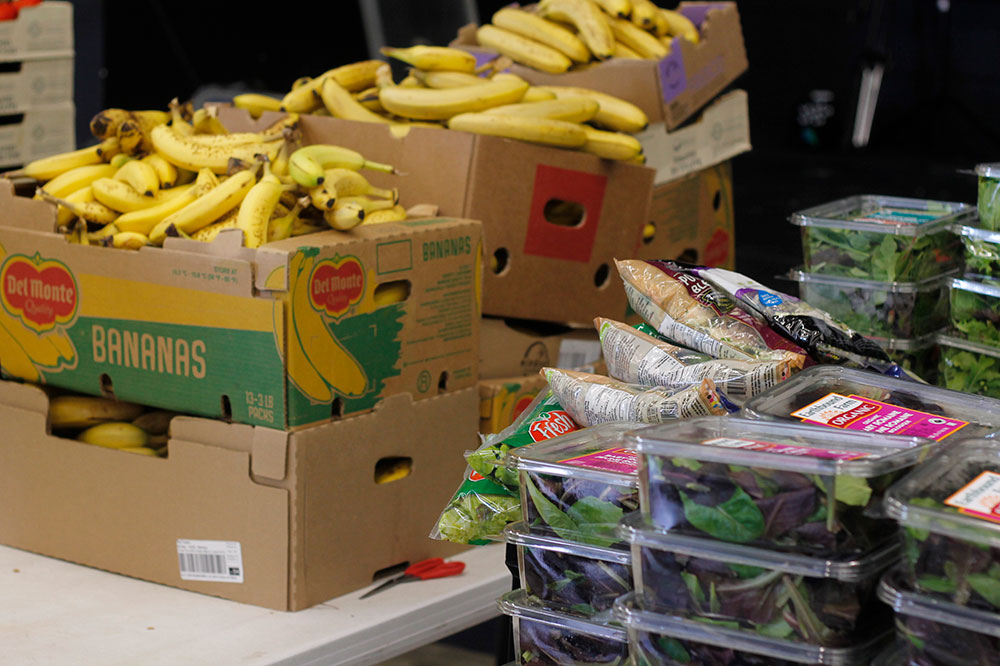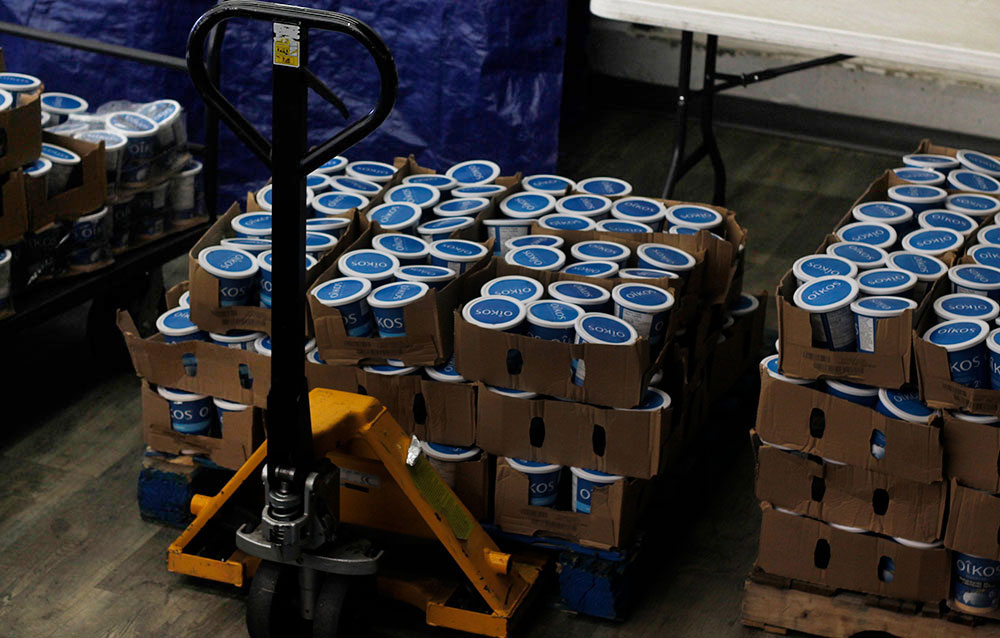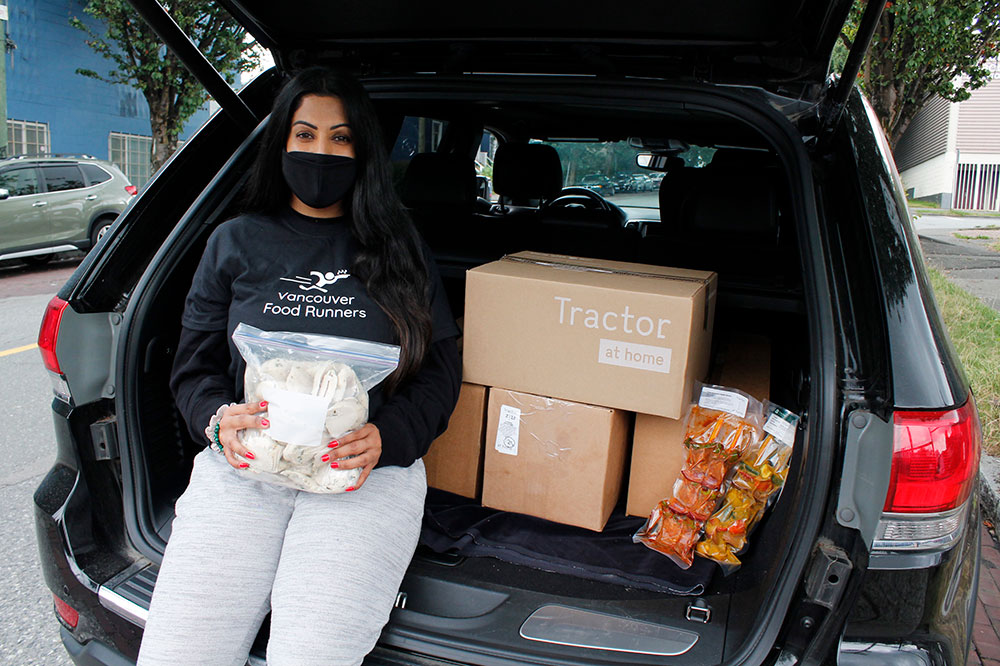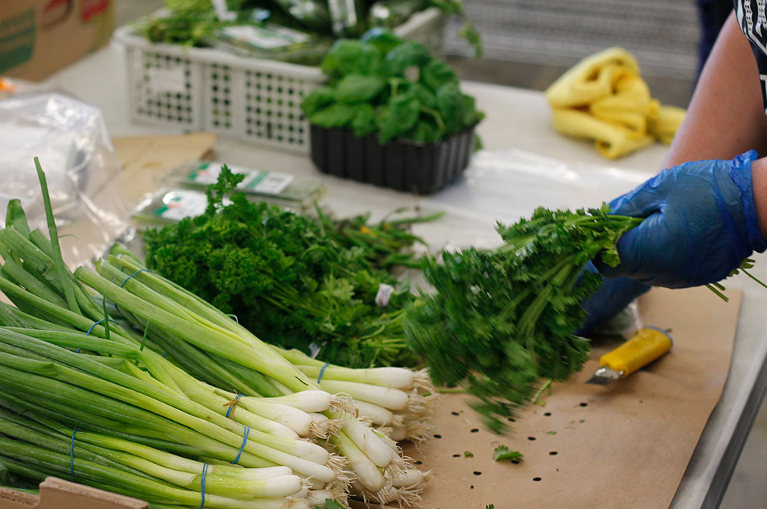When the doors open at the Food Stash Foundation’s rescued food market, eight senior shoppers rush in, set their shopping buggies by the door and hustle over to the boxes of fresh vegetables, greens and fruit.
There’s a bit of elbowing and neck craning as they quickly assess what they want and bundle it away in their tote bags. Three large boxes full of tomatoes, spinach, cucumber, strawberries, mangoes, oranges, potatoes, zucchini, apples, mushrooms, peppers and herbs are emptied in under a minute.
Then they line up at the counter for half a dozen eggs, a four-litre jug of milk and a cut of frozen meat, excitedly comparing what they got.
Before they walk out the door some pause to drop a handful of change in a box, while others simply nod in thanks.
Market staff and volunteers wave the shoppers off, close the door behind them, and restock the shelves. Then they let in the next eight shoppers, and the cycle repeats.
The rescued food market runs every Thursday from 3 to 5:30 p.m. and has a pay-what-you-can system, says executive director Carla Pellegrini. In an average week 120 people will donate less than $2 each and receive around 20 pounds of food, she says.
The market is open to everyone, no questions asked, and is stocked with surplus food from farms, grocers and wholesalers.
“Surplus food” is fresh, nutritious food that was labelled as waste by the food industry. It isn’t saleable through regular channels because it might be too small, too “ugly,” or a crop might produce more than a farmer is able to sell.
But instead of ending up in the garbage or compost it’s being distributed to individuals and households who will use it to feed themselves, their families and their neighbours.
To wrap up this series on accessing fresh, affordable food in an urban setting I’m focusing on food waste. Could we eat better by changing what we consider “waste”?
The average Canadian household spends $1,766 annually on groceries that end up in the garbage. Metro Vancouver estimates 13,000 tonnes of healthy, edible food ends up at the region’s transfer station each year. In Canada 58 per cent of the food produced domestically is wasted every year, equal to about 35.5 million tonnes. More than 30 per cent of that “waste” could be rescued — equal to 11.2 million tonnes of healthy, edible food.
If our global food system was a country, it would be the third largest greenhouse gas emitter in the world, after China and the United States.
That’s a lot of food thrown out, especially considering 5.8 million people, including 1.8 million children, were food insecure in Canada’s 10 provinces in 2021, meaning households had inadequate or insecure access to food due to financial constraints, according to the research group Proof.
“Food insecurity impacts so many people from a wide range of socioeconomic statuses,” says Pellegrini. “Working professionals, young families, seniors. Vancouver is a really expensive city to live in and wages aren’t keeping up with inflation.”
This leads to a pretty surprising statistic: for every grocery store in Canada, there are six non-profits working on food security — in total, about 60,000 non-profits serving 6 million Canadians.
But some smart people are connecting the dots and recognizing so-called food waste as the valuable resource it is. Non-profits, charities and phone apps are working to “rescue” food waste from ending up in the landfill.


If food can be rescued it means that, despite being given the label of a ‘waste product’ it’s still perfectly edible — fresh, even! The food sorted by volunteers at rescued food orgs wouldn’t be out of place at a regular grocery store. Photos by Michelle Gamage.
The Too Good To Go app lets you buy discount food from around Vancouver that would otherwise be thrown out that day, like baked goods from a café, pizza from a by-the-slice takeout counter, or wilting produce from a small grocery store. I’ve used the app a handful of times and would recommend sticking to several-hours-old pizza instead of groceries, which have been a hit-and-a-miss. One time I got a fist-sized steak and five potatoes for $5 — great! But another time, for the same amount of money, I got rancid chicken and mouldy apples.
Another app-based initiative is the non-profit Vancouver Food Runners, which organizes volunteers to pick up food and deliver it to local non-profit organizations around the Lower Mainland.
Vancouver Food Runners focuses on small-scale rescues from 160 donors which can be transported by one of their 2,000 volunteers to one of the 105 non-profits they’ve partnered with, says founder Tristan Jagger. They deliver about 10,000 pounds of food per month.
“We’re kind of an Uber Eats for free food for people who need it,” she says.
Since launching in March 2020, Vancouver Food Runners has rescued over 1.2 million pounds of food, which is equal to around 1 million meals, according to its website.

When Vancouver Food Runners gets a notice that one of its 160 donors has food it wants rescued, the organization puts a call-out through its app, asking one of its 2,000 volunteers to pick up the food and deliver it to a non-profit organization in the Lower Mainland. Photo by Michelle Gamage.
If the rescued food can’t easily fit in a single volunteer’s car, Vancouver Food Runners will call Food Stash Foundation, which has access to five drivers, three trucks, a 371-square-metre warehouse and around 90 volunteers, Pellegrini says.
Food Stash Foundation rescues between 80,000 to 85,000 pounds of food each month. That’s the equivalent of the total weight of a herd of 15 to 18 African elephants, she says.
Around three-quarters of that food is delivered to 35 non-profits and charities, most of which are located in Vancouver’s Downtown Eastside, she says. The remaining quarter is divided between the foundation’s food box delivery program and its rescued food market. Food boxes are delivered to 120 households and contain 25 pounds of fresh fruits, vegetables, dairy and meat. They’re delivered to folks who self-identify as house-bound, for example with a chronic illness. A weekly box costs $10 and subscribers are encouraged to make requests about what they’d like to see included in their boxes.
“We want to emphasize dignified food access,” Pellegrini says. “They should be able to pick and choose food they like and want to eat just like anyone else.”
The rescued food market runs every Thursday and serves between 100 to 120 folks, Pellegrini says. Volunteers sort the food beforehand so they can stock the shelves in stages and ensure everyone gets the same amount of food, she says — so there’s no need to line up early, or fight over space. Some seniors have been lining up as early as 9 a.m., even though market doors open at 3 p.m., and Pellegrini says she worries about them waiting in the hot sun all day.
The Food Stash Foundation was also stocking a fridge for the Vancouver Community Fridge Project, but has paused for a couple weeks while the foundation moves down the street. The foundation puts around 2,000 to 4,000 pounds of food in the fridge every week, she says.
The project has installed five fridges around the city. Their purpose? Same as any fridge — to open up when you get hungry. This laterally directed mutual aid provides free, safe, non-policed, accessible and nutritious food, according to its website. Anyone can stock a fridge and anyone can take from a fridge.
CityReach Care Society is the big leagues, distributing weekly food hampers to up to 1,000 families per week. Before the pandemic they fed around 100 families, but the economic hardship caused by COVID increased households in need exponentially, says Cheryl McManus, assistant executive director.
CityReach is a faith-based organization but they distribute rescued and donated food to everyone, McManus says. However, registration filled up in 2021 and the charity is currently not able to assist any additional households, she says.
McManus says they work with 20 food rescue partners, including Vancouver Food Runners and Food Stash Foundation, and in 2021 rescued $3.2 million worth of food, equal to one million meals, or 47,000 food hampers.
A single food hamper weighs around 20 pounds and comes with a dairy, grains, deli and a perishable component, she says, adding families can choose what type of meat they get. A family of five of more will get two hampers per week, and a family of nine or more will get three. Any family member can pick up the hamper in a week and the food is all pre-sorted into hampers, so there’s no need for families to rush to be the first to pick up, McManus says.
She’s not sure if CityReach will be able to expand because over the last year most of the rescuable food in the Lower Mainland and parts of the Interior was claimed. “There’s not much room to grow,” she says.
Maybe large food waste resources like farms or grocery stores have all been partnered off, but there’s still a lot of edible food ending up in the trash from smaller sources.
Pellegrini is working on some alternative solutions for expanding Food Stash Foundation, for example.
A lot of the time when food gets thrown out it could actually be donated, she says.
Some companies will donate produce but throw out dairy or meat products that are close to their best before dates, Pellegrini says. But a best-before date rates when a food is at peak freshness, and is very different from an expiry date, which is an estimation of when a food could spoil, she says.
Pellegrini says the Food Stash Foundation team carefully checks all of the food that is donated to them to ensure they don’t hand out spoilt food.
“It’s easier and cheaper to just throw food away instead of find someone who could use it,” she says.
Easier and cheaper, sure, but it also takes away from people in the city who could have eaten it instead — and from healthy cultures and vibrancy within Vancouver.
During a recent town hall with the Joyce Street Action Network, which is advocating to protect businesses that act as community spaces for people of Filipino, Korean and Chinese descent from development, Gillian Der 謝美華 says she heard the rising cost of food is putting people in “survival mode.”
Der is the food justice co-ordinator for Renfrew-Collingwood Food Justice at the Collingwood Neighbourhood House.
“When you go into that survival mode you don’t have the chance to have a life or enjoy it because you’re just worried about ‘how do I make my rent, how do I get myself fed, what jobs do I have to work and how many hours do I need in order to make ends meet this month?’” Der says.
Folks currently in survival mode are largely marginalized, racialized, potential newcomers or English-language learners, they say. These folks are also likely to not have access to higher-paying jobs which could could relieve some of their financial worries. That keeps them in survival mode and takes away from their ability to participate in their culture and transmit that culture to their children, families and community.
“The privilege of being able to transmit your culture is only given to a few,” she says. This is part of why Vancouver “feels so sterile,” they add.
Der says this is why it’s important to protect culturally appropriate and affordable food sources, like the food hub on Joyce Street, which is currently threatened by development.
Restaurants there sell culturally appropriate, fast and large portions of food that can easily be bought by people on their way to work, commuting between jobs or heading home after work, they say.
Members of the Renfrew-Collingwood Food Justice initiative define culturally appropriate food as food that feeds your soul, connects you with your culture, community or home country and is food that your ancestors ate and celebrated.
If people can’t find nearby grocery stores stocked with this food or time to cook it at home they will lose this connection to their culture.
“What will happen to the health of our communities if people can’t eat the foods that their people have been eating for millennia?” Der asks.
The journey to reducing waste, saving on grocery money and freeing up time to practice our cultures could start by educating children about their food and having them be more connected to where it comes from, says Jennifer Grenz, assistant professor at the University of British Columbia faculty of forestry and faculty of land and food.
Grenz says her family used to raise chickens for food, a practice her kids grew up thinking was “normal.”
“They’d shame each other if someone wasted food, saying ‘someone had to die for you to eat that,’” she says. “Honouring that life goes into not taking more than you need, which comes from having a relationship with food.”
Grenz says when she learned the Three R’s in school — reduce, reuse and recycle — she went home and shamed her mom for throwing a can in the garbage.
“But there’s no way my mom would have known any different,” she says.
By teaching kids new ways to think about food we also teach their families and slowly start to change the current global and domestic food industry, she says.
I agree with Grenz — but I can’t wait for the kids to grow up and change the system. I’m hungry now.
I’ve been working on this series for about one month.
In that time I’ve met people who have transformed underused green space into thriving community farms and discovered the wealth of urban farmers from whom I can buy local produce. I now know that if and when my community garden plot is ripped out for a condo development, I can take over a boulevard in my neighbourhood to start growing herbs and greens instead. I’ve been introduced to an online marketplace where I can buy affordable produce grown in the Lower Mainland — and have the option to subsidize my weekly grocery bill if money is ever tight.
I’ve added free local fruit to my list of seasonal goodies grown in the city, and will be raising questions about adding more fruit and nut trees to Vancouver’s canopy and berry bushes to its green spaces during the upcoming civic election.
I’ve learned what seafood and seaweed I can safely, sustainably and responsibly harvest from local beaches. I’ve found new so-called weeds I can harvest from around town for a free salad, though I’ll be avoiding harvesting from parks in the future. And I’ve found a fun, educational resource to learn about edible plants in my neighbourhood.
I’ve also discovered an industry feeding food-insecure families with a previously overlooked resource and a pay-what-I-can market where I can fill a tote bag bursting with food.
I’ve discovered a lot of ways to add to my pantry, but no single way to protect my kitchen, and my belly, from the ever-increasing stresses and threats caused by climate change.
But I find comfort in the fact that I’ve only been doing this for one month. I’m wrapping up this series but my quest for accessing fresh, affordable and ethical foods will continue.
Der says eating together “builds connections across classes and cultures and neighbourhoods.”
So as new and innovative solutions pop up in my city I’ll be here, excitedly holding a knife and fork and waiting to dip into new and delicious food solutions — inviting people to sit with me so we can brainstorm a better world together.
Happy eating. ![]()
Teaser photo credit: A CityReach Care Society volunteer helps sort herbs for the organization’s weekly food hamper program, which provides food for up to 1,000 households in a regular week. The bulk of this food was considered ‘waste’ at one point by the food industry. Photo by Michelle Gamage.





